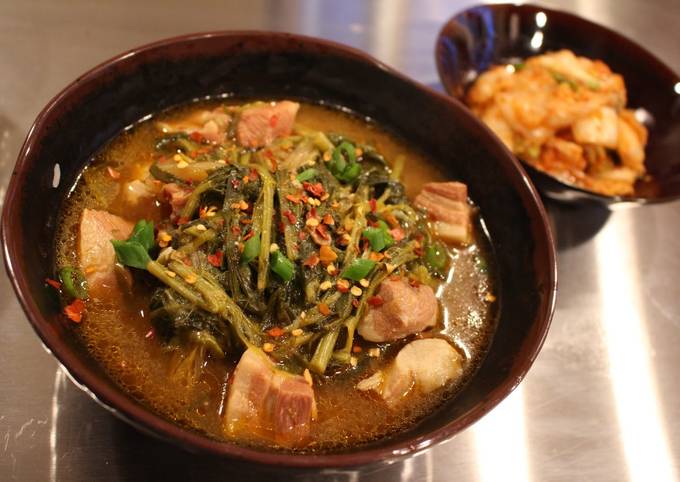Dwenjang Guk (Spicy, Hearty Korean Style Miso Soup). This cabbage soup (Baechu Dwenjang Guk) made with Korean fermented soybean paste (deonjang/dwenjang) is the ultimate comfort food for A hearty, spicy miso soup dish made by adding Korean chilli miso paste (gochujang) and root vegetables to a Japanese miso soup recipe. How to make authentic Korean soybean paste soup (Doenjang Guk). Also find out the difference between Doenjang Guk and Doenjang Jjigae!
 As a savory and spicy dish, Jaeyook Bokkeum is a perfect example of Korean Anju.
See recipes for Dwenjang Guk (Spicy, Hearty Korean Style Miso Soup) too.
There are some elaborate Korean soups and stews that take quite a bit more work to make, but Dwenjang Guk (DWENjahng GOOHK) - dwenjang meaning Korean style miso and guk meaning soup - is a super.
You can cook Dwenjang Guk (Spicy, Hearty Korean Style Miso Soup) using 14 ingredients and 7 steps. Here is how you cook it.
As a savory and spicy dish, Jaeyook Bokkeum is a perfect example of Korean Anju.
See recipes for Dwenjang Guk (Spicy, Hearty Korean Style Miso Soup) too.
There are some elaborate Korean soups and stews that take quite a bit more work to make, but Dwenjang Guk (DWENjahng GOOHK) - dwenjang meaning Korean style miso and guk meaning soup - is a super.
You can cook Dwenjang Guk (Spicy, Hearty Korean Style Miso Soup) using 14 ingredients and 7 steps. Here is how you cook it.
Ingredients of Dwenjang Guk (Spicy, Hearty Korean Style Miso Soup)
- It's 5 cups of unsalted stock (chicken, pork, beef, turkey and veg all work fine).
- It's 5 cups of water.
- It's 1/2 of an onion, cut into thirds.
- You need 4 of garlic cloves, peeled and crushed.
- It's 1/4 cup of dwenjang (or miso if you don't have dwenjang, but dwenjang is usually much more pungent).
- Prepare 2 Tablespoons of to 1/4 cup gochujang (Korean chili paste), depending on how hot you like things.
- Prepare 2 teaspoons of sugar (to round out the flavors and the salt from the pastes).
- Prepare of salt and/or fish sauce if needed to adjust the seasoning.
- You need 8 cups of leafy green veg, fresh or extruded (it'll look like a lot, but it will reduce quite a bit after cooking).
- You need 1-2 of fresh jalapeños or serranos if you like a little extra heat and chili flavor (optional).
- It's of Optional if you'd like protein (you can do one or the other, or half of each):.
- It's 1 pound of pork shoulder or beef stew meat cut into 1-inch cubes (optional, but it helps to have a little protein if you're going to make a meal of it).
- Prepare of or.
- Prepare 1 package of medium or firm tofu (usually 12 to 14 ounces), drained and cut into 1-inch cubes.
A hearty, spicy miso soup dish made by adding Korean chilli miso paste (gochujang) and root vegetables to a Japanese miso soup recipe. Adding Korean spices and chilli to a quintessential bowl of miso can give a richer taste and aroma that compliments miso's normal umami flavour. Simple and savory homemade miso soup with dashi stock, detailed recipe instructions on how to cook different types of miso soup. More complicated and hearty stews (jjigaes) Instead of relying on pure salt, cooks season these dishes with soy sauce, salted baby shrimp (saewoojut), fermented miso (daenjang), dried.
Dwenjang Guk (Spicy, Hearty Korean Style Miso Soup) step by step
- Put the stock, water, onion, garlic, dwenjang, gochujang, sugar, meat and any extruded veg into a large pot (fresh veg goes in later). Bring to a boil, covered, over medium high heat (should take 15 minutes or so)..
- Once it's come to a boil, turn the heat down to medium low and simmer, covered, for another 20 minutes before adding any fresh veg and tofu..
- Simmer another 10 minutes or so, then adjust the seasoning for salt. If you've added fresh veg and/or tofu, you will almost certainly need to adjust for the water they will release into the soup..
- Simmer another 15 minutes with the lid askew, adjust seasoning one last time if needed, and that's it!.
- If you want to have it with rice, you'll want to put the rice on to cook when you leave the soup to simmer the first time..
- It's always yummier with kimchi. Here's my kimchi recipe (which of course you would have to have made days to weeks in advance): https://cookpad.com/us/recipes/1567994-kimchi-easier-than-you-think.
- EXTRUDING LIQUID FROM GREENS: Just wash the greens, sprinkle them with salt, and let them sit for a couple of hours, tossing them 2 or 3 times during the process, letting the salt draw the moisture from them. After they've released the excess liquid, just give them a good swish in a big bowl full of clean water, and squeeeeeeeze all that liquid out. You can then freeze the greens for future use, or refrigerate them for 2 to 3 weeks before using..
Spicy seafood and meat mixed noodle soup (Jjamppong: 짬뽕). I've updated it here with new and updated soup recipes since then. · This cabbage soup (Baechu Dwenjang Guk) made with Korean fermented soybean paste (deonjang/dwenjang) is the ultimate comfort food · Sauteed Eggplant with Spicy Miso Sauce - Get this traditional Japanese classic sauteed eggplant with spicy miso sauce recipe from Pickled Plum. This Korean-inspird spicy miso sauce is great with grilled or steamed meat, seafood, or even as a dipping for vegetable crudités (fresh vegetable sticks). Additionally, red miso or brown rice miso should be used for this soup. They (darker miso generally) are closer in taste to the Korean soybean paste (doenjang or dwenjang).